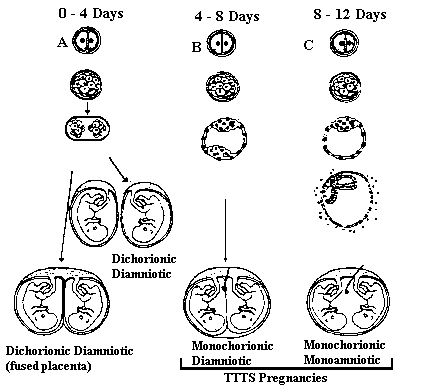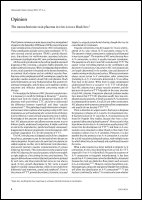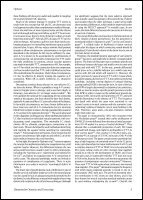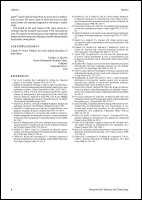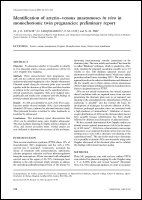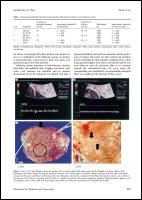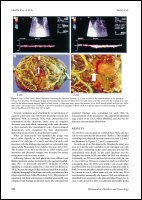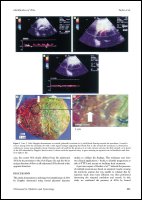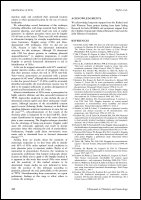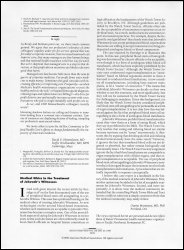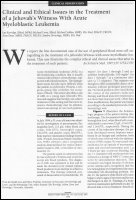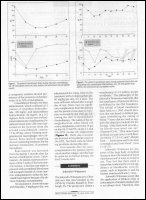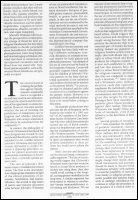Jehovah God Does Allow Natural Whole Blood Transfusions
Andrew W. Lusk
In 1990, the Watchtower Bible and Tract Society of New York, Inc. (herein called the "Watchtower") made one of its most remarkable statements ever with respect to its ban on blood transfusions for its members -- the Jehovah's Witnesses. Found in the "Questions from Readers" section of the June 1, 1990 edition of The Watchtower magazine, pages 30 to 31 (transcript attached as Appendix 1), the following is stated:
"It is significant that the blood system of a pregnant woman is separate from that of the fetus in her womb; their blood types are often different. The mother does not pass her blood into the fetus. Formed elements (cells) from the mother's blood do not cross the placental barrier into the fetus' blood, nor does the plasma as such. In fact, if by some injury the mother's and the fetus' blood mingle, health problems can later develop (Rh or ABO incompatibility). However, some substances from the plasma cross into the fetus' circulation. Do plasma proteins, such as immune globulin and albumin? Yes, some do.
"A pregnant woman has an active mechanism by which some immune globulin moves from the mother's blood to the fetus'. Because this natural movement of antibodies into the fetus occurs in all pregnancies, babies are born with a degree of normal protective immunity to certain infections.
"It is similar with albumin, which doctors may prescribe as a treatment for shock or certain other conditions. Researchers have proved that albumin from the plasma is also transported, though less efficiently, across the placenta from a mother into her fetus.
"That some protein fractions from the plasma do move naturally into the blood system of another individual (the fetus) may be another consideration when a Christian is deciding whether he will accept immune globulin, albumin, or similar injections of plasma fractions. One person may feel that he in good conscience can; another may conclude that he cannot. Each must resolve the matter personally before God."
In the Watchtower's mind, researchers had clearly proved that these human blood components naturally transfer from one human being (the mother) to another human being (the fetus). Clearly, in the mind of the Watchtower, as God's Chosen Organization, Jehovah cannot be breaking His own law. Thus, the Watchtower allowed Jehovah's Witnesses to use their own free will and conscience in deciding whether to accept transfusions of certain human blood components. A far cry from a disfellowship/disassociation action that meant the loss of God, certain death at Armageddon and shunning by family and friends for knowingly taking a "banned" blood component transfusion or a whole blood transfusion.
The Watchtower re-emphasized this 1990 doctrine change on the natural blood component transfer in the "Question From Readers" section of the June 15, 2000 edition of The Watchtower magazine, pages 29-31.
But, even with this change in 1990 the Watchtower continued to ban transfusions of human whole blood and the blood components -- red blood cells, platelets and plasma. The Watchtower also officially banned white blood cell transfusions unless it is was termed a peripheral blood stem cell autographing procedure (which is really a fancy word for a white blood cell transfusion -- see Appendix 5).
But what if there was a way that Jehovah God actually allowed for the natural transfer of whole blood between two humans? And if researchers have proved a natural whole blood transfer just like they proved the natural transfer of albumin, what would this mean?
Obviously, as shown in 1990, the Watchtower (as God's Chosen Organization) clearly recognized that if researchers actually proved a blood component naturally transfers between two humans, then the Watchtower recognized Jehovah God cannot break His own law. And since Jehovah cannot break His own law, whole blood transfusions, if proven, would have to be a matter for a Jehovah's Witness' conscience and free will and would not be a cause for a disfellowship/disassociation action.
So is there any research with pictorial evidence to prove God actually allows whole human blood to naturally transfer between two human beings (individuals)?
Well, whatever side of the abortion issue you are on, just remember that "God's Chosen Organization," the Watchtower, has stated publicly that a fetus is an individual human being.
Over the past twenty or so years there has been a lot of scientific research into twins. Why? Well thanks to some of the technology around today to help moms and dads have children, more couples than ever before are having twins, triplets and more. To moms and dads so desperate for just one baby, there is nothing quite like two or more healthy babies. But twins can have risks such as in a few cases of monochorionic (MC) pregnancies -- thus, the need for research.
What the heck is a monochorionic pregnancy? Well it's a fancy way of saying that mommy is going to have identical twins. A chart in Appendix 2 shows how the fetuses are formed from the time the egg is fertilized with the sperm. What makes monchorionic pregnancy unique is that the fetuses (individual human beings) share one placenta. A placenta is the organ that unites the fetus to the mother's uterus and allows for a metabolic exchange to let the fetus live off the mother's nutrients.
Researchers such as Dr. Geoffrey Machin and Dr. M. J. O. Taylor (just to name a few) have published outstanding research on monochorionic pregnancy in recognized medical journals such as Ultrasound in Obstetrics and Gynecology.
So what does an identical twin pregnancy (monochorionic twin [MC] gestation) have to do with a transfusion of human whole blood? Well let's look at the medical research.
Dr. Machin published an opinion titled "The monochorionic twin placenta in vivo is not a black box" in the January, 2001 edition of Ultrasound in Obstetrics and Gynecology, Volume 17, Issue 1, pages 4-6 (attached Appendix 3).
Dr. Machin clearly makes reference to vascular connections in the placenta of monochorionic pregnancies. These vascular connections unite the blood system of both fetuses in the placenta. There are three different ways that the fetuses' blood systems are connected. From artery to artery (A-A), vein to vein (V-V) or artery to vein (A-V). Sentence 2 in paragraph 5 of Dr. Machin's article says it all:
"The majority of MC twin placentae have A-V connections, so there is usually intertwin transfusions."
So there you have it, recognized medical research identifying two individual human beings (fetuses) naturally transferring whole blood. This is nothing new as noted in Dr. Machin's reference list at the end of his article. Clearly, the reference list shows a lot of medical research had been done in this field in the 1980s and 1990s.
But why do this research? Well about 88 percent of the time, monochorionic fetuses are born as beautiful twins. But, about 12 percent of the time a condition called twin to twin transfusion (TTT) syndrome occurs. TTT syndrome means one fetus donates too much blood to the other fetus through the vascular connections of the shared placenta. If left untreated, TTT syndrome has a 20 percent survival rate.
Dr. Taylor et al. published a medical research article titled "Identification of arterio-venous anastomoses in vivo in monochorionic twin pregnancies: preliminary report" in the September 2000 edition of Ultrasound in Obstetrics and Gynecology, Volume 16, Issue 3, pages 218-222 (attached Appendix 4). When reviewing the article, keep in mind that "arterio-venous anastomoses" means an artery to vein connection (AVA). An "arterio-arterial anastomoses" (AAA) is an artery to artery connection.
The medical article provides more research that identified both AAA and AVA connections in the shared placenta. As well, Taylor's research provides pictures of the actual placenta and other images using spectrum Doppler ultrasound. Thus your own eye can clearly see the vascular connections of one fetus' blood system with the other fetus' blood system at their shared placenta. Taylor et al. also identified which way the whole blood naturally flowed from one twin to the other twin at these vascular connections using formal injection studies and the Doppler ultrasound techniques. Like Dr. Machin, Taylor's reference list shows that the medical community has been well aware of this natural blood transfer for sometime.
Some may express a concern that the Watchtower would continue the ban of whole blood transfusions because Twin to Twin Transfusion (TTT) syndrome is a "freak of nature" that "kills" humans. Yet, this topic deals with the natural blood transfers in ALL monochorionic twin fetuses and not just the 12% of monchorionic twin fetuses (Taylor et al.) that develop TTT syndrome. So why does TTT syndrome happen? Dr. G. Machin opinion paper (Appendix 3) states the following:
"The connections traverse a special zone of the MC placenta, called the vascular equator, which runs roughly at right angles to a line joining the two cord insertions."
Thus, Dr. Machin explains that the blood systems of each fetus are being connected in a special zone (called the "vascular equator") on the placenta that the fetuses share. Later in the opinion paper, Machin states this:
"Vascular connections cross the equator in three ways: arterio-arterial (A-A), veno-venous (V-V) and arterio-venous (A-V). The anatomy of these connections is explained and illustrated in our recent paper6. The majority of MC twin placentae have A-V connections, so there is usually intertwin transfusion. The question is: why don't most MC twins develop TTT? The answer is that everything depends on the combination and direction of connections. Outcomes in MC twin pregnancies are largely determined by the number, type and diameter of vessels running on the placental surface. Whereas transfusion always occurs across A-V connections, other connections (including A-A, V-V and contra-directional A-V) can allow flow back to the donor. When there is under-compensated unidirectional flow in a 'causative' A-V, TTT will develop. Each MC placenta has a unique vascular anatomy, and spectrum of severity of TTT depends on the exact anatomy of each MC placenta. Postpartum placental perfusion studies have shown that TTT MC placentae usually have less complicated vascular anatomy, in which a causative A-V connection is compensated for poorly, if at all, by any other connections. MC placentae with numerous connections allow compensation and usually do not develop TTT."
As Dr. Machin suggests in the opinion paper, fetuses sharing one placenta is sub-optimal compared to having a placenta for each fetus. But, Jehovah God's own answer to protect the fetuses in a monchorionic (MC) gestation is to provide a natural complicated vascular structure on the "vascular equator" zone of the placenta with many artery and vein connections. The increase in vascular connections provides more (not less) whole blood to naturally transfer between fetuses. And the more natural connections and transfusions of whole blood, the chances of a TTT syndrome occurrence are significantly reduced and not enhanced.
It is surprising, if not downright unbelievable that a Watchtower organization who boasts of its on staff doctors, its Hospital Information Service (HIS) and its Hospital Liaison Committee to assist doctors, hospitals and Witness patients, and who reviews and quotes from thousands of medical and scientific journals has never brought this "natural transfer" of whole blood between two individual humans to the attention of the Rank and File.
Conclusion
Medical research has, for sometime, identified that Jehovah God actually allows for the natural transfer of whole blood between two separate humans. Researchers have clearly proved and even provided pictures showing the phenomena exists in their studies of monochorionic pregnancies.
As shown in 1990, the Watchtower (as God's Chosen Organization) recognized that if researchers actually proved a blood component naturally transfers between two humans, then the Watchtower recognized Jehovah God cannot break His own law. The Watchtower has recognized two separate humans as being a mother and a fetus. Obviously two fetuses are also considered separate individual human beings to the Watchtower.
And since Jehovah cannot break His own law, then whole blood transfusions should be a matter for a Jehovah's Witness' conscience and free will. There is now no (nor should there have been any) justification for a disfellowship/disassociation action for those Witnesses who take/took whole blood transfusions.
Appendix 1
The Watchtower, June 1, 1990, pages 30-31.
Questions From Readers
Do Jehovah's Witnesses accept injections of a blood fraction, such as immune globulin or albumin?
Some do, believing that the Scriptures do not clearly rule out accepting an injection of a small fraction, or component, taken from blood.
The Creator first laid upon all mankind the obligation to avoid taking in blood: "Every moving animal that is alive may serve as food for you ... Only flesh with its soul -- its blood -- you must not eat." (Genesis 9:3, 4) Blood was sacred and so could be used only in sacrifice. If not used in that way, it was to be disposed of on the ground. -- Leviticus 17:13, 14; Deuteronomy 12:15, 16.
This was no mere temporary restriction for Jews. The need to abstain from blood was restated for Christians. (Acts 21:25) Around them in the Roman Empire, God's law was commonly broken, since people ate food made with blood. It was also broken for "medical" reasons; Tertullian reports that some men took in blood thinking that it could cure epilepsy. 'They quaffed with greedy thirst the blood of criminals slain in the arena.' He added: "Blush for your vile ways before the Christians, who have not even the blood of animals at their meals." Jehovah's Witnesses today are just as determined not to violate God's law, no matter how common it is for others to eat food made with blood. In the 1940's, blood transfusions came into widespread use, and the Witnesses saw that obeying God required that they also avoid blood transfusions, even if doctors urged these.
At first, most transfusions were of whole blood. Later, researchers began to separate blood into its primary components, for doctors concluded that a certain patient might not need all major parts of blood. If they gave him only one component, it would be less risky for him, and the doctors could get more use out of the blood available.
Human blood can be separated into dark cellular material and a yellowish fluid (plasma, or serum). The cellular part (45 percent by volume) is made up of what are commonly called red cells, white cells, and platelets. The other 55 percent is the plasma. This is 90 percent water, but it carries small amounts of many proteins, hormones, salts, and enzymes. Today, much of the donated blood is separated into the primary components. One patient may be given a transfusion of plasma (perhaps FFP, fresh frozen plasma) to treat shock. But an anemic patient might be given packed red cells, that is, red cells that had been stored and then put in a fluid and transfused. Platelets and white cells are also transfused but less commonly.
In Bible times men had not devised such techniques for using these components. God simply commanded: 'Abstain from blood.' (Acts 15:28, 29) But why should anyone think that it would make a difference whether the blood was whole or had been separated into these components? Though some men drank blood, Christians refused even if it meant death. Do you think that they would have responded differently if someone had collected blood, allowed it to separate, and then offered them just the plasma or just the clotted part, perhaps in blood sausage? No, indeed! Hence, Jehovah's Witnesses do not accept transfusions of whole blood or of its primary components (red cells, white cells, platelets, or plasma) used to accomplish a similar purpose.
As the question suggests, though, scientists have learned about specialized blood fractions and how to employ such. A common issue involves the plasma proteins -- globulins, albumin, and fibrinogen. Likely, the most widespread therapeutic use of such is injecting immune globulin. Why is that done?
Your body can produce antibodies against certain diseases, giving you active immunity. This is the basis for advance inoculation with a vaccine (toxoid) against polio, mumps, rubella (measles), diphtheria-tetanus-pertussis, and typhoid fever. However, if someone has recently been exposed to certain serious diseases, physicians may recommend an injection of a serum (antitoxin) to give him immediate passive immunity. Until recently such injections have been made by extracting immune globulin, which contains antibodies, from a person already immune.* The passive immunity gained from the injection is not permanent, for the injected antibodies pass out of his system in time.
In view of the command to 'abstain from blood,' some Christians have felt that they should not accept an immune globulin (protein) injection, even though it was only a blood fraction. Their stand is clear and simple -- no blood component in any form or amount.
Others have felt that a serum (antitoxin), such as immune globulin, containing only a tiny fraction of a donor's blood plasma and used to bolster their defense against disease, is not the same as a life-sustaining blood transfusion. So their consciences may not forbid them to take immune globulin or similar fractions.* They may conclude that for them the decision will rest primarily on whether they are willing to accept any health risks involved in an injection made from others' blood.
It is significant that the blood system of a pregnant woman is separate from that of the fetus in her womb; their blood types are often different. The mother does not pass her blood into the fetus. Formed elements (cells) from the mother's blood do not cross the placental barrier into the fetus' blood, nor does the plasma as such. In fact, if by some injury the mother's and the fetus' blood mingle, health problems can later develop (Rh or ABO incompatibility). However, some substances from the plasma cross into the fetus' circulation. Do plasma proteins, such as immune globulin and albumin? Yes, some do.
A pregnant woman has an active mechanism by which some immune globulin moves from the mother's blood to the fetus'. Because this natural movement of antibodies into the fetus occurs in all pregnancies, babies are born with a degree of normal protective immunity to certain infections.
It is similar with albumin, which doctors may prescribe as a treatment for shock or certain other conditions.* Researchers have proved that albumin from the plasma is also transported, though less efficiently, across the placenta from a mother into her fetus.
That some protein fractions from the plasma do move naturally into the blood system of another individual (the fetus) may be another consideration when a Christian is deciding whether he will accept immune globulin, albumin, or similar injections of plasma fractions. One person may feel that he in good conscience can; another may conclude that he cannot. Each must resolve the matter personally before God.
[Footnotes]
* With recombinant DNA, or genetic-engineering, techniques, scientists are developing similar products that are not made from blood.
* One example is Rh immune globulin, which doctors may recommend when there is Rh incompatibility between a woman and her fetus. Another is Factor VIII, which is given to hemophiliacs.
* Evidence shows that nonblood volume replacement fluids (such as hetastarch [HES]) can be used effectively to treat shock and other conditions for which an albumin solution might have been used previously.
Appendix 2
Monozygotic Twinning
In human pregnancy if the fertilized egg (embryo) splits after four days, a particular type of identical twin pregnancy occurs known as monochorionic. The later an embryo splits, the thinner the membrane and the more problems that may occur. Most TTTS pregnancies are monochorionic-diamniotic. They can also be monochorionic-monoamniotic. They are always monochorionic. This chart shows the different ways an embryo may split to make identical, like sexed babies, depending on how many days after conception. After 12 days, there would be siamese, or conjoined twins.
In these cases the twins share a unified placenta. Studies of these placentas indicate that, almost invariably, communicating blood vessels are found within the placenta which connect the umbilical cords and circulations of the twins. It is approximately 12% of the time, that the sharing becomes so disproportionate or uneven that the syndrome occurs.
Appendix 3
"Opinion -- The monochorionic twin placenta in vivo is not a black box", Dr. Geoffrey A. Machin, January 2001 edition, Ultrasound in Obstetrics and Gynecology, Volume 17, Issue 1, pages 4-6 (click on the pictures to enlarge).
Appendix 4
"Identification of arterio-venous anastomoses in vivo in monochorionic twin pregnancies: preliminary report", Dr. M. J. O. Taylor et al., September 2000 edition Ultrasound in Obstetrics and Gynecology, Volume 16, Issue 3, pages 218-222 (click on the pictures to enlarge).
Appendix 5
"Medical Ethics in the Treatment of Jehovah's Witnesses", Dr. Osamu Muramoto, May 25, 1998 edition Archives of Internal Medicine, Volume 158, Editor's Correspondence, pages 1155-1156 (click on the pictures to enlarge).
Medical Ethics in the Treatment of Jehovah's Witnesses
I read with great interest the recent article by Kerridge et al1 on the first documented case of the use of peripheral blood stem cell autografting in a Jehovah's Witness. This case has a profound bearing on the medical ethics of treating Jehovah's Witnesses. As new technologies evolve around blood-based treatments, whether such treatments are acceptable to Jehovah's Witnesses has become a complex issue. One of the most difficult aspects of caring for Jehovah's Witnesses in recent years is that such decisions are often arbitrarily made by local church officials on hospital liaison committees or high officials at the headquarters of the Watch Tower Society in Brooklyn, NY. Although guidelines are published by the Watch Tower Society, officials often rule on the acceptability of uncommon treatments on an individual basis. As a result, medical articles sometimes report inconsistent practices. For example, despite the frequently used guidelines2 that clearly state that Jehovah's Witnesses do not accept predeposited blood, reports show that some are willing to accept treatments involving predeposited autologous blood or blood components.
The case reported by Kerridge et al illustrates this point. In this case, peripheral blood stem cell autografting was determined by church officials to be acceptable, even though it is a form of autologous white blood cell transfusion, which has been explicitly prohibited by the Watch Tower Society.2 Although the Watch Tower Society once condemned organ transplantation as "cannibalism" based on biblical arguments similar to those it has used to condemn blood transfusions, it now considers all transplantations, including bone marrow transplants, to be a "matter of conscience."3 This means that individual Jehovah's Witnesses can decide on their own whether to use this treatment, and more significantly, that they will not be ostracized by the Watch Tower Society for challenging its mandates. Given this background, it is likely that the Watch Tower Society considered peripheral blood stem cell autografting to be permissible as a form of organ transplantation. It is not clear how this was balanced against the fact that peripheral blood stem cell autografting is also a form of autologous blood transfusion.
Jehovah's Witnesses prohibit blood transfusions because they view them as a form of eating blood, which they say is prohibited in the Bible. The Watch Tower Society teaches that eating and infusing blood are similar because nutrients can be "eaten" intravenously. It illustrates this by arguing that drinking alcohol and infusing alcohol intravenously have the same result.4 However, it ignores the fact that transfused blood cells are not digested or absorbed, but rather remain biologically and functionally intact. The Watch Tower Society's argument ignores the fact that blood transfusions are comparable to organ transplantation with cellular organs, and that organ transplantation is acceptable. The use of peripheral blood stem cell autografting in Jehovah's Witnesses is noteworthy in this regard because the treatment involves both transplantation and transfusion, 2 procedures that are virtually impossible to separate conceptually.
I believe this case report is a landmark in the history of the medical treatment of Jehovah's Witnesses. First, another option may be added to the list of acceptable treatments for Jehovah's Witnesses. Second, and more importantly, it is about time the medical community demanded that the controlling Watch Tower Bible and Tract Society codify its rules into a simple consistent whole that the medical community may easily follow.
Osamu Muramoto, MD, PhD
Portland, Ore1 Kerridge I, Lowe M, Seldon M, Enno A, Deveridge S. Clinical and ethical issues in the treatment of a Jehovah's Witness with acute myeloblastic leukemia. Arch Intern Med. 1997;157:1753-1757. MEDLINE
2 Dixon JL, Smalley MG. Jehovah's Witnesses: the surgical/ethical challenge. JAMA. 1981;246:2471-2472. MEDLINE
3 Questions from readers: could a Christian accept a bone-marrow transplant since blood is made in the marrow? Watchtower. 1984;5/15:31.
4 Watch Tower Bible and Tract Society of Pennsylvania. Reasoning From the Scriptures: 1989. Brooklyn, NY: Watch Tower Bible and Tract Society of Pennsylvania; 1989:73.
The views expressed herein are personal and do not reflect those of Kaiser Permanente health maintenance organization or Pacific Northwest Permanente PC.
"Clinical and Ethical Issues in the Treatment of a Jehovah's Witness With Acute Myeloblastic Leukemia", Dr. Ian Kerridge et al., August 25, 1997 edition, Archives of Internal Medicine, Volume 157, pages 1753-1757 (click on the pictures to enlarge).
